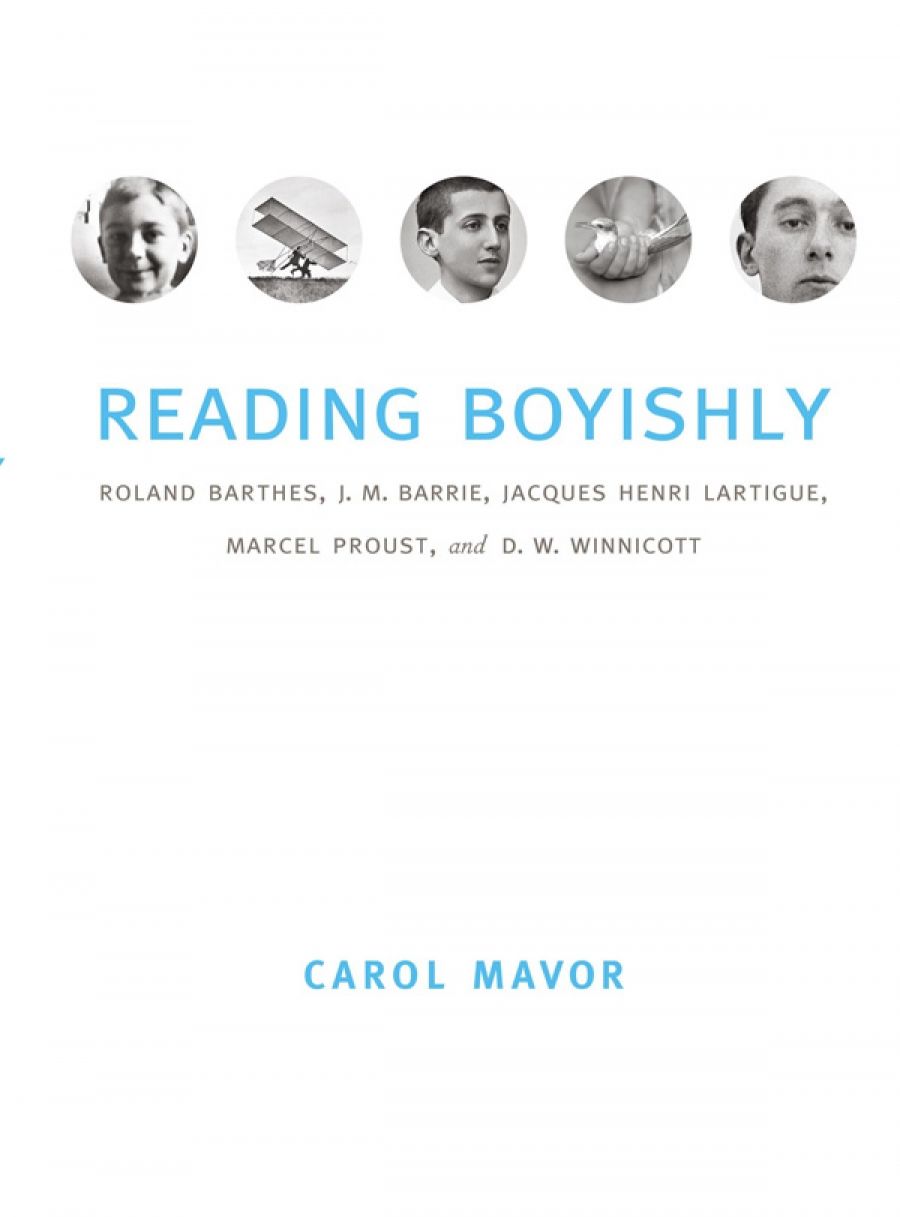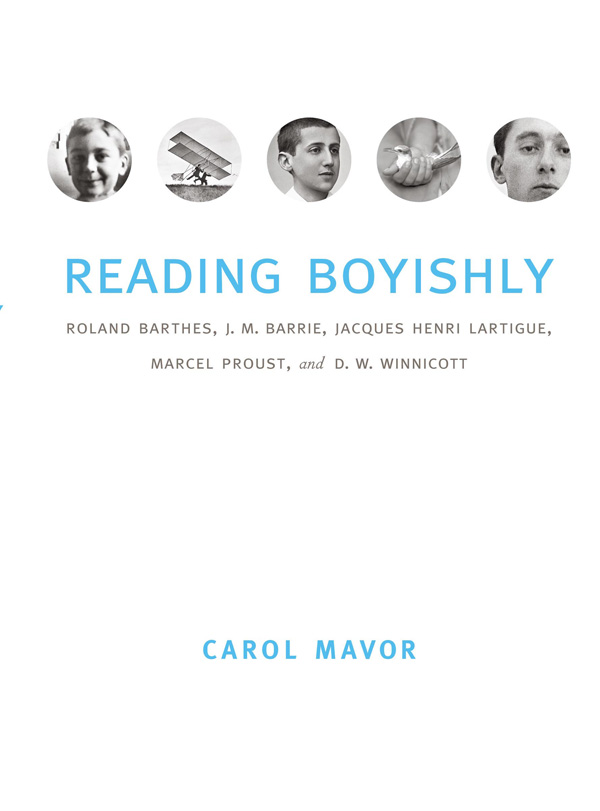
- Free Article: No
- Custom Article Title: Disease of longing
- Review Article: Yes
- Article Title: Disease of longing
- Online Only: No
- Custom Highlight Text:
Carol Mavor is professor of Art History and Visual Studies at the University of Manchester: a specialist in the field of Victorian photography who has written two earlier books on the subject. She is also one of those rare figures capable of subverting orthodox academic research by stealing some of autobiography’s subjective insight and creative writing’s imaginative reach.
- Book 1 Title: Reading Boyishly
- Book 1 Subtitle: Roland Barthes, J.M. Barrie, Jacques Henri Lartigue, Marcel Proust and D.W. Winnicott
- Book 1 Biblio: Duke University Press, $59.95 pb, 536 pp
- Book 1 Cover Small (400 x 600):

- Book 1 Cover (800 x 1200):

Reading Boyishly, her 500-plus page anatomy of boyishness in three writers (Roland Barthes, J.M. Barrie, Marcel Proust), a photographer (Jacques Henri Lartigue), and a psychoanalyst (D.W. Winnicott), combines personal whim, wilful eclecticism of subject matter and a comfortable acquaintance with post-structuralist, psychoanalytic, feminist and queer theory. Ostensibly, it is critical theory’s house style that Mavor employs. Much of Reading Boyishly is written in academic idiolect, with its thesaurus-raiding repetitions, Lacanian puns, brackets, slashes and synonymic twinning, onomatopoeic flourishes, neologisms and etymological regressions, and so on.
But Mavor is too enthusiastic to be a euphuist. Her Barthes is the author of Camera Lucida and the autobiographical Incidents rather than of S/Z; and her compulsive digressiveness owes more to In Search of Lost Time than Of Grammatology. She may have recourse to the vocabulary, but her larger project is obedient to poet Louis Zukovsky’s dictum: ‘Love is to reason as the eyes are to the mind. No one who adores with such sweet transparency the books, images and ideas under discussion could belong to that cooler caste.’
Indeed, Mavor – like W.G. Sebald, Walter Benjamin and Gaston Bachelard before her – is a thinker who allows the idea to shape the structure of the work that contains it. In these pages, for instance, she literally attempts to read and write boyishly – which is to say she tries to ‘covet the mother’s body as a home both lost and never lost, to desire her only as a son can’. This enigmatic formula makes more sense when we learn of Barthes’s description of a writer as someone who ‘plays with his mother’s body … in order to glorify it, or embellish it, in order to dismember it, to take it to the limit of what can be known about the body’.
The result is a reading of five (loosely, in chronological terms) Edwardian lives built on brilliant maternal sympathy – an extended argument in favour of keeping apron-strings between mother and son firmly tied – which also shares something of the youthful ardour and childish caprice of its subjects. Mavor picks up texts and images and clutches them to her chest, or casts them aside for another, or else arranges them according to some eye-catching grouping of colour and shape. The result is an act of psychosexual cross-dressing that begs a lighter, more open and tangential form (all qualities Barthes thought good readings of Proust should display).
Mavor’s flitting, Peter Pan-like approach has the virtue of appreciating her eternal youths on their own terms, and not judging their (mainly queer) refusals to grow up and away from their mothers as a failure or declination from some adult (heterosexual) norm – the fear of which she calls ‘effeminophobia’: ‘To read boyishly is to embrace effeminophobia and to boldly, if quietly, articulate the effeminizing relation between a boy and his mother as a specific and beautiful production.’ Despite the various relationships between each subject and their mother, Mavor works to bind them using common motifs, beginning with the deceptively simple image of string:
Let it suffice to say that ‘string-tied’ [is] one of this books richest metaphors for speaking to that continually linked, if imaginatively so, umbilicus between boyish men and their mothers and the ‘aesthetically productive’ work of Barrie, Barthes, Lartigue, Proust and Winnicott …
Almost immediately, she sets about complicating the metaphor so that the text gets tangled up in alternative readings. Starting with Winnicott’s key essay from Playing and Reality, ‘Transitional Objects and Transitional Phenomena’ (1951) – which explores the relationship between ‘play, subjectivity and the weaving of a relationship between mother and son’ through the clinical history of a boy with a tendency to ‘string things together’ – Mavor traces the psychoanalytic origin of the apron-string cliché, quoting Winnicott’s conclusion ‘that the string was simultaneously a symbol of separateness and of union through communication’.
Lest this seem too pat, Mavor moves to make the metaphor strange and playful again, this time using the defamiliarising agency of visual art. So it is that a photograph of Marcel Duchamp’s 1942 exhibition in New York, in which the artist spun sixteen miles of string around the works on display, is followed by Baldovinetti’s quattracento painting Madonna in a Landscape, where the infant holds one end of his ‘unbound swaddle turned ribbon turned umbilical’ towards his mother, like ‘a banderole waiting for inscription’.
This constant oscillation, between image, text and idea, throws up some startling and unlikely connections: the religious iconography underlying the scallop-shape of Proust’s famous madeleine, for instance; or the constant recourse to images of sewing and weaving in Barrie’s fiction and drama, in half-conscious celebration of his mother’s occupation; or the link between fairy-sightings and the invention of the Box Brownie camera; or the deep feminist affinities between a 200-minute German film from 1975, Jeanne Dielman, and Proust’s ‘4500 page labyrinth’.
The more than two hundred accompanying images, from Victorian photographs to old master paintings, contemporary works of art to film stills, form an exquisite assemblage in their own right: a visual anthology that reinforces, juxtaposes or simply riffs upon the textual content in a manner halfway between a po-faced textbook and Sebald’s ghostly uncaptioned inclusions.
Although each of the five figures is granted his own chapter, common metaphors breed and multiply throughout the text, threading the lives (queer or straight, artist or writer) together in a shared nostalgia – Mavor calls it a ‘disease of longing’ – for boyhood and the maternal dispensations it holds. However, as Barthes explains, nostalgia does have its uses: he sees childhood as the ‘royal road by which we know a country best’. ‘Ultimately,’ he concludes of his geographic travels, ‘there is no country but childhood’s.’
In making an atlas of these five boyhoods, it should be admitted that Mavor’s work suffers from gigantism. Ideas and themes are scribbled into obscurity by constant outlining. But just as Lartigue’s ‘photographic ecstasies of release, flight, hustle and bustle’ captured his subjects in blurry freedom instead of crisp fixity, Mavor’s method also uses intentional technical failure as a means of achieving an idiosyncratic success. How else was she to capture the nostalgia and the poetry of reading boyishly?


Comments powered by CComment